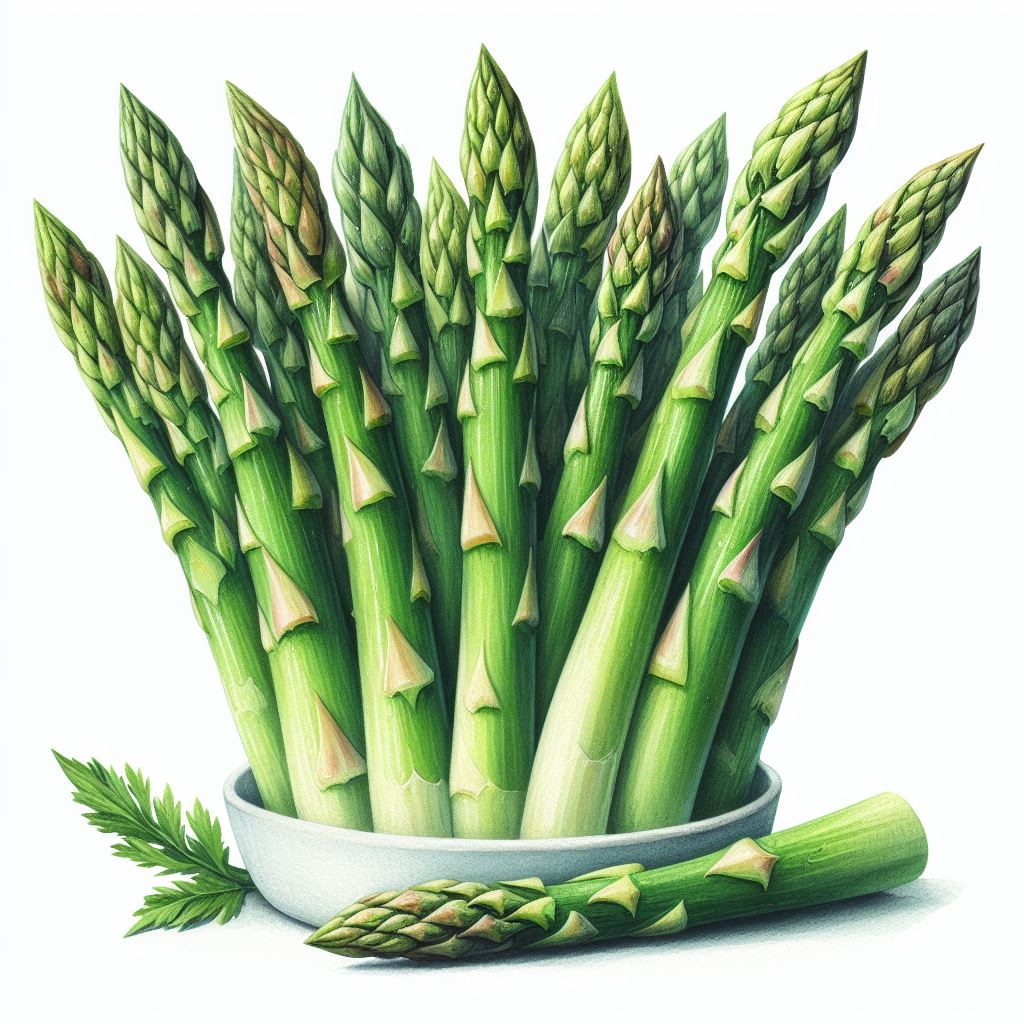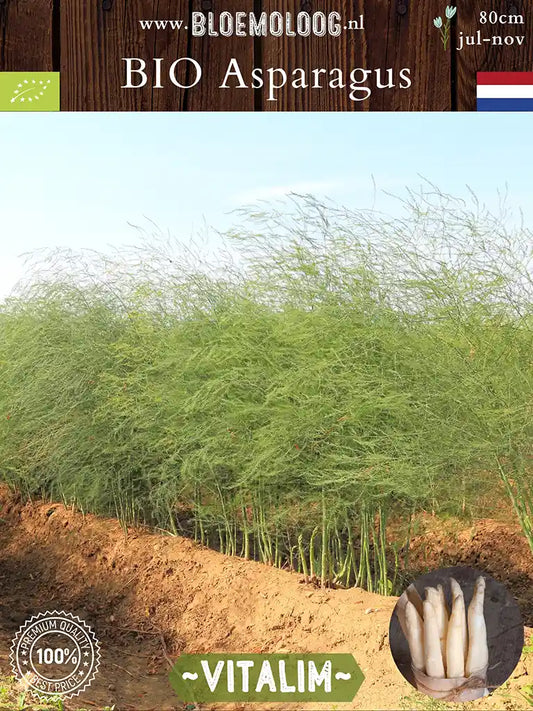Organically grown asparagus claws
Not everyone likes asparagus, but we certainly can't advise anyone against growing asparagus themselves. The plant itself is quite an appearance with its striking leaves, which grow quite high during development. They are perennials that come back faithfully every year.
Asparagus contains nutrients such as vitamin C, vitamin K, folate and fiber and is also a good source of antioxidants.
Edible
Asparagus that are intended for consumption grow from the asparagus plants of the Bloemoloog. Asparagus can be prepared in various ways, including roasting, grilling, steaming or boiling. Because they are more tender than white asparagus, they often need a shorter cooking time.
Click here for delicious recipes from Chef Alain from Binnenstebuiten TV.
Growing green asparagus
The Bio Asparagus 'Vegalim' is a green asparagus. The most striking feature of the green asparagus is, of course, the green color of the stalks. Unlike the white asparagus, the green asparagus grows above ground and is exposed to sunlight, allowing photosynthesis to take place. Green asparagus is grown in a similar way to white asparagus, but with one important difference: it is not covered with soil during growth. Because it grows above ground, it has no protection from sunlight, which results in its green color.
Green asparagus tends to have a slightly stronger flavor than white asparagus. They also tend to be a little more tender and juicy.
Growing white asparagus
The Bio Asparagus 'Vitalim' is an asparagus plant that is suitable for growing white asparagus. When growing white asparagus, it is important to cover the asparagus claws with a thick layer of soil during the growing season, which is also called an asparagus ridge. This process is known as "earthing up" or "bleaching" and is essential to prevent the asparagus from turning green due to exposure to sunlight. In the dark, the plant does not produce chlorophyll, which is why it remains white.
White asparagus is softer and has a less intense flavor.
How, where and when do I plant claws from an asparagus plant?
The ideal time to plant asparagus claws is in early spring, when the soil has warmed up but before the asparagus begins its active growing period.
Dig trenches about 6 to 8 inches deep. Leave at least 3 feet of space between the trenches. Place the asparagus claws in the trench with the buds facing up. Leave about 12 to 18 inches of space between each claw. Cover the claws with about 2 to 3 inches of soil. As the asparagus grows, gradually add more soil until the trench is level with the soil surface.
Planting white asparagus
For white asparagus, begin by gradually adding soil to the furrow or bed in which the asparagus claws are planted. Do this as the asparagus grows, and continue to fill the furrow until it is approximately 20 to 30 cm above the original ground level.
If you only have 1 asparagus to try, dig it in at the same depth as described above but without a furrow.
Water the asparagus beds thoroughly after planting to settle the soil and get the asparagus off to a good start. Consider mulching the asparagus beds to retain moisture, reduce weed growth, and stabilize the soil temperature.
Location
Asparagus grows best in full sun, in well-drained soil with a pH between 6.5 and 7.5. A well-drained soil is essential to prevent root rot. Sandy soil is ideal, but light loam soil is also good. In any case, not too heavy clay.
Caring for the asparagus plant
Asparagus needs regular watering, especially during dry spells. Water deeply to ensure the roots remain well hydrated. When the plant has completely died back in the fall, the remains are cut back to the ground to prevent pests and diseases.
Asparagus beds can last for decades if properly maintained. Continue to feed the plants and maintain good soil health.
For organic potting soil, plant food and other soil improvers we recommend Bio Kultura !
How to harvest asparagus
Don't start harvesting until the second year after planting the asparagus claws. In the first year it is important to let the plants grow and become stronger.
Harvesting green asparagus
Harvesting green asparagus begins when the stalks have reached the desired height, usually between 20-25 centimeters. They are simply cut with a knife just above the soil surface. The harvest season for green asparagus is often slightly longer than that of white asparagus. It begins in spring and can continue into early summer, depending on growing conditions and climate.
Harvesting white asparagus
White asparagus should be harvested when it reaches a height of about 20-25 centimeters. This is the time when it is still growing underground and retains its characteristic white color. The harvest season for white asparagus is shorter than that of green asparagus, from March to June.
Harvesting white asparagus that grows underground requires care and precision to avoid damaging the stalks. Use a special asparagus pick or knife. This tool is designed to cut the asparagus underground without damaging the roots or other stalks.
Locate the asparagus bud by gently pushing away the soil around the asparagus with your hand. The asparagus bud is located at the top of the stalk. Insert the asparagus pick or knife about 6 to 8 inches (15 to 20 centimeters) below the ground, near the base of the stalk, and carefully cut through the stalk. Cut at an angle, just below the asparagus bud. Gently pull the cut asparagus up out of the ground. Make sure to leave the length of the stalk intact.
Continue harvesting the white asparagus until all the mature stalks have been harvested. Because white asparagus is only harvested once a year, it is important to be careful not to damage the plants.
After the asparagus has been harvested, the hole in the ground is refilled using a rake or simply by hand.
Propagation
Asparagus claws can become thicker over time. You may choose to divide older plants to obtain new root cuttings. Replant the root cuttings in the desired location.
Origin of the asparagus plant
Asparagus is an ancient vegetable that has been cultivated for thousands of years. The origins of asparagus probably lie in the coastal regions of Europe, Western Asia and North Africa. The ancient Egyptians, Greeks and Romans were familiar with asparagus and valued it for both culinary and medicinal reasons. Asparagus was considered a delicacy and was believed to have medicinal properties, such as a beneficial effect on the kidneys.
Buy organic asparagus
You can buy organic asparagus plants from January to April at Bloemoloog.nl.





